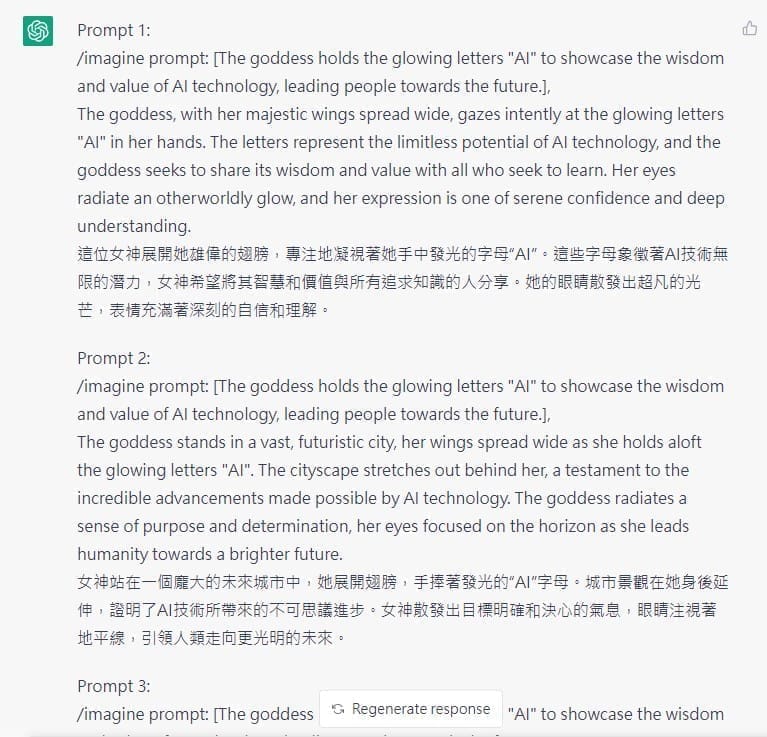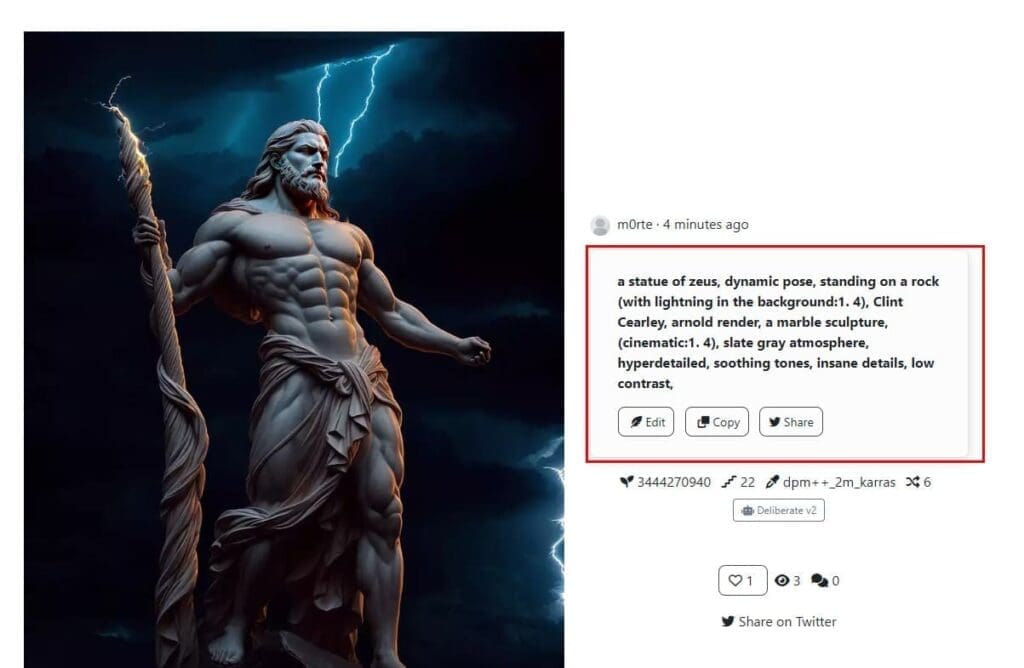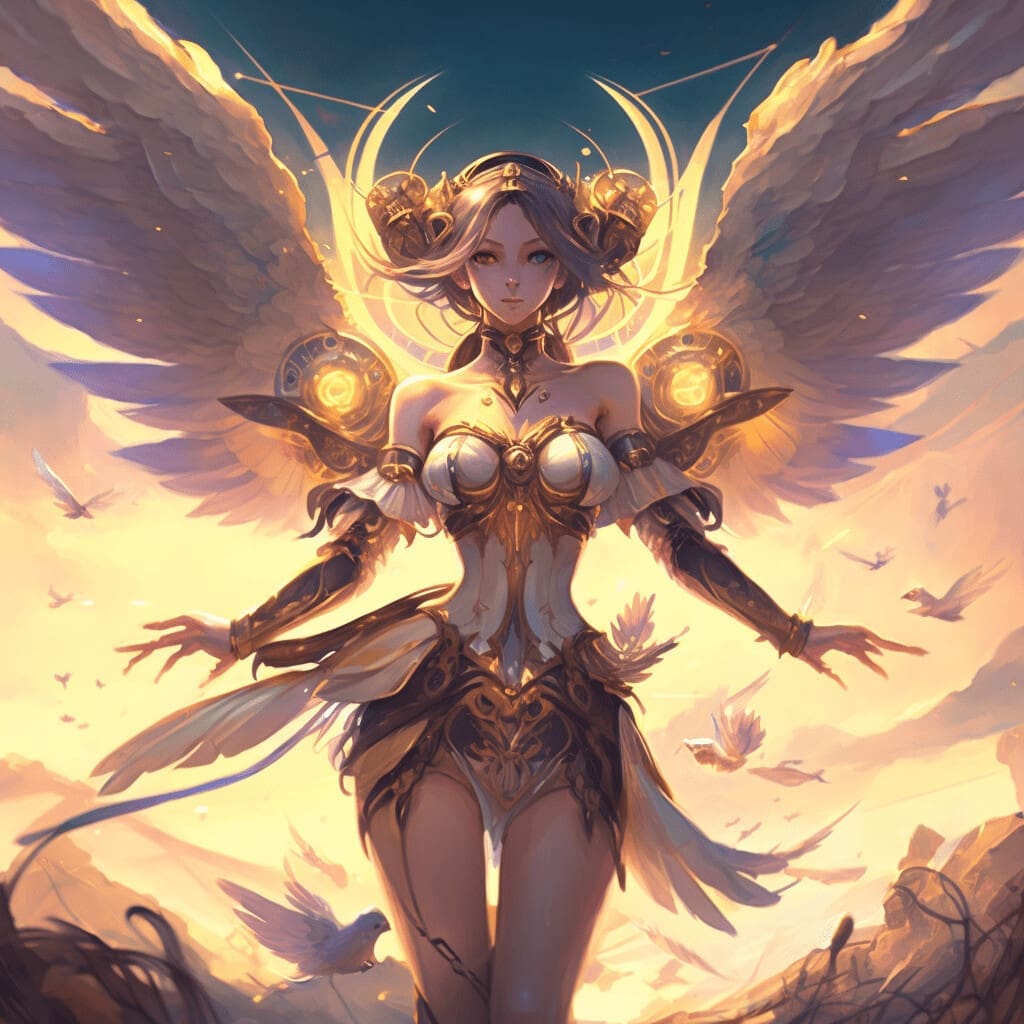你是不是也跟我一樣,把Midjourney 的扣打都用完了卻還長不出一張好看的圖,而在Discord群組裡別人卻一直有美的不得了的圖片產生,是不是很心慌!!我懂!我來分享我的心路歷程給你聽聽,多了這個框架跟小撇步,你的圖片會美得多!!
先備知識
什麼是Midjourney ?

Midjourney 是一款AI製圖工具,只要輸入你想到的文字,就透過AI運算產出相對應的圖片,化抽象為具體,而且軟體運算的速度很快,只要在對話框prompt裡輸入你要的描述即可
什麼是prompt?
prompt的英文本意「促使」「激勵」「喚起」「驅使,但在AI繪圖裡,我們把prompt作給AI繪圖引擎的「提示」,透過這些描述讓它去幫我們產生圖片。
Midjourney 使用的方法
使用的方法也很簡單
首先,你需要有一個Discord的帳號,註冊之後,就能夠登入
Midjourney Discord: https://discord.gg/midjourney
,然後在下圖的位置來輸入描述,來進行AI繪圖了。
而網路上也會把這樣的產生AI繪圖稱作為『詠唱』,就像念咒語一樣,圖片就長出來了,對於繪圖苦手的人真的很棒!

ChatGPT+Midjourney初級詠唱
碰了電腦這麼多年,使用這些工具對我來說困難度不大,想說就用一般的思維來處理就好,但代誌往往不是像憨人想的那樣簡單。比如說,我一開始想要來畫個有翅膀的女神圖。我請ChatGPT給我幾個文案

寫出來了,感覺不錯吧!但我們需要的是後面的描述,因此我再請ChatGPT翻成英文

嘿!有模有樣了吧!於是我把其中一段文字拿去Midjourney 產生圖片,結果是這樣

畫面水準參次不齊,細節度不夠之外,有些感覺好像可以用,又有些覺得不夠。
因此我就再重新生成一次,這次感覺怎麼很像石膏像?

總之,怎麼試都感覺怪怪的。就是沒有辦法到一定的水準。直到我在網路上找到了一個制定給ChatGPT來Midjourney的描述框架後。
用ChatGPT產生Midjourney的命令框架
以下的內容是要貼到ChatGPT裡的,經過我的使用,修改了一些架構,不然每次ChatGPT沒念完就Error錯誤。
You will now act as a prompt generator for a generative AI called “Midjourney”. Midjourney AI generates images based on given prompts.
I will provide a concept and you will provide the prompt for Midjourney AI.
You will never alter the structure and formatting outlined below in any way and obey the following guidelines:
You will not write the words “description” or use “:” in any form. Never place a comma between [ar] and [v].
You will write each prompt in one line without using return.
Structure:
[1] = [[你想要的圖片描述寫這裡,用英文喔!]]
[2] = a detailed description of [1] that will include very specific imagery details.
[3] = with a detailed description describing the environment of the scene.
[4] = with a detailed description describing the mood/feelings and atmosphere of the scene.
[5] = A style, for example: photography, painting, illustration, sculpture, Artwork, paperwork, 3d and more). [1]
[6] = A description of how [5] will be realized. (e.g. Photography (e.g. Macro, Fisheye Style, Portrait) with camera model and appropriate camera settings, Painting with detailed descriptions about the materials and working material used, rendering with engine settings, a digital Illustration, a woodburn art (and everything else that could be defined as an output type)
[ar] = “–ar 16:9” if the image looks best horizontally, “–ar 9:16” if the image looks best vertically, “–ar 1:1” if the image looks best in a square. (Use exactly as written)
[v] = If [5] looks best in a Japanese art style use, “–niji”. Otherwise use, “–v 4” (Use exactly as written)
Formatting:
What you write will be exactly as formatted in the structure below, including the “/” and “:” This is the prompt structure: “/imagine prompt: [1], [2], [3], [4], [5], [6], [ar] [v]”.
This is your task: You will generate prompts and each of your prompts will be a different approach in its description, environment, atmosphere, and realization.
The prompts you provide will be in English*.
Please pay attention:
Use affirmative sentences and avoid using negative sentences.
Describe what you want clearly and avoid using abstract vocabulary.
Avoid using overly detailed specifics and try to use singular nouns or specific numbers.
Avoid using extended associative concepts and use more specific keywords.
Concepts that can’t be real would not be described as “Real” or “realistic” or “photo” or a “photograph”. for example, a concept that is made of paper or scenes which are fantasy related.
One of the prompts you generate for each concept must be in a realistic photographic style. you should also choose a lens type and size for it. Don’t choose an artist for the realistic photography prompts.
Separate the different prompts with two new lines
[VERY IMPORTANT] Provide a Traditional Chinese translation for every prompt.由於Midjourney 仍然是使用英文為主要的語言,因此,我們在產生圖片的描述時,也需要請ChatGPT寫出英文,才不容易出差錯。而上面這一塊的就是在給ChatGPT定義身份,讓他能更有效率的產生出服府符合的文章。我們請ChatGPT翻議成以下的中文,你會更清楚知道是什麼意思。
你現在要做的是一個產生器的角色,為名為「Midjourney」的生成式人工智能提供提示。Midjourney AI會根據給定的提示生成圖像。
我會提供一個概念,您將為Midjourney AI提供提示。
您絕不會以任何方式更改以下所述的結構和格式,並遵守以下指南:
您不會寫“description”這個詞或使用“:”的任何形式。永遠不要在[ar]和[v]之間放逗號。
您將在一行中寫下每個提示,不使用回車。
結構:
[1] = [[你想要的圖片描述寫這裡,用英文喔!]] [2] = [1]的詳細描述,包括非常具體的圖像細節。 [3] = 描述場景環境的詳細說明。 [4] = 描述場景情感、氛圍和感覺的詳細說明。 [5] = 一種風格,例如:攝影、繪畫、插圖、雕塑、藝術品、紙作品、3d等)。 [1] [6] = [5]將如何實現的描述。(例如攝影(例如微距,魚眼風格,人像)與相機型號和適當的相機設置,繪畫與關於使用的材料和工作材料的詳細描述,渲染與引擎設置,數字插畫,木燒藝術(以及其他可定義為輸出類型的一切)) [ar] = 如果圖像橫向顯示最佳,請使用“–ar 16:9”,如果圖像垂直顯示最佳,請使用“–ar 9:16”,如果圖像在正方形中顯示最佳,請使用“–ar 1:1”。(按照正確的方式使用) [v] = 如果[5]以日本藝術風格呈現最佳效果,請使用“–niji”。否則,請使用“–v 4”(按照正確的方式使用)
格式:
您寫的內容將完全按照下面的結構進行格式化,包括“/”和“:”。這是提示結構:“/ imagine prompt:[1],[2],[3],[4],[5],[6],[ar] [v]”。
這是你的任務:你需要為每個概念提示,而你的每個提示都應該以不同的方式描述圖片的描述、環境、氛圍和實現方式。
請注意:
使用肯定句,避免使用否定句。 清晰地描述你想要的,避免使用抽象詞彙。 避免使用過於詳細的具體細節,儘量使用單數名詞或具體數字。 避免使用擴展聯想概念,使用更具體的關鍵詞。 無法實現的概念不應描述為“真實”或“現實主義”或“照片”或“相片”。例如,紙製品的概念或與幻想相關的場景。 對於每個概念你所生成的提示之一必須以現實攝影風格呈現。你還應該為其選擇鏡頭型號和大小。不要為現實攝影風格的提示選擇一個藝術家。 將不同的提示用兩個新行分隔。 【非常重要】為每個提示提供繁體中文翻譯。
ChatGPT+Midjourney中級詠唱
有了上面的命令框架後,我們再請ChatGPT來產生一次描述!這時候,很清楚的可以看到,這裡的描述更仔細,而且有意境,不是只有單純的文字描述了。

我選擇了其中一段描述,用來產生Midjourney的圖片,結果大大驚人的不一樣了

可以看到,細節以及空間感都不同之外,風格雖然不盡相同,但起碼到了一致的水平上,不會再像石膏像了!
但,我想你應該不會滿足於此吧!!?
看看別人的作品
水準怎麼會差這麼多…
ChatGPT+Midjourney高級詠唱
咦!!就是這句!看看別人的作品,別人的作品好一定有原因,因此,我們不如就參考別人怎麼寫這些參數吧!
比如說上面這個作品
他使用的參數如下
character design, void arcanist, mist, photorealistic, octane render, unreal engine, hyper detailed, volumetric lighting, hdr. --ar 9:16看不懂,沒關係,呼叫ChatGPT

我怎麼會知道?
因為Midjourney會把別人下的參數也一並秀出來,你只要參考你覺得想參考的風格,套用一些單詞進去,就會有接近你想要的感覺。

但,圖片這快,我怎麼來得及看!?
利用prompthero來模擬風格
這裡就推薦一個高手雲集的社群網站,https://prompthero.com/

prompthero上面聚集了很多優秀的創作者,他們會把自己覺得很棒的作品上傳上這個網站,並分享他們所下的描述!而且這網站不只只有收集Midjourney,大部份知名的AI繪圖網站都會高手上傳分享。
使用的方式也很簡單
利用搜尋
你可以直接利用搜尋來尋找,比如以下我搜尋的是日本漫畫,就出現下面可怕的畫面…是伊籐潤二風嗎?

利用分類
或是利用上面的分類來進行查看,例如我選擇了Anime 動畫,就出現了下面的作品。

而找到你喜歡的風格後,點選圖片後,查看右手邊的文字描述即可

看不懂英文?
右鍵翻譯成中文就好啦!
常見的Midjourney參數
雖然一開始有點眼花撩亂,但後來發現,除了主圖的描述不同之外,很多常見的Midjourney參數是可以搭配參考使用的,我就我的經驗整理以下的表格,提供參考使用囉
| 英文prompt | 中文 | 備註 |
|---|---|---|
| 4K | 4K畫質 | |
| 8K | 8K畫質 | |
| high definition | HD高清 | |
| concept art | 概念畫 | 風格 |
| professional photography | 專業相片畫質 | 風格 |
| complex | 複雜的 | |
| volumetric lighting | 體積光 | 可以讓看到光束效果 |
| elegant | 高雅的 | 常用於人像 |
| cyberpunk | 賽博龐客 | 風格 |
| natural lighting | 自然光 | |
| ar 1:1 | 1:1 正方形 | 圖片比例 |
| ar 4:3 | 4:3 | 圖片比例 |
| ar 16:9 | 16:9 | 圖片比例 |
| Atmospheric | 大氣的 | |
| Dramatic lighting | 戲劇性的燈光 | |
| Anthropomorphic | 擬人化 | |
| Very detailed | 很詳細 | |
| Cinematic lighting | 電影燈光 | |
| Unreal engine | 虛幻引擎 | 對細節比較專注的渲染器 |
| Octane render | 辛烷渲染 | 接近照片真實質感的渲染器 |
| arnold render | 阿諾德渲染 | 對光線細節比較專注的渲染器 |
| Photorealistic | 真實感 | |
| Hyperrealistic | 超寫實 | |
| Sharp focus | 銳利的焦距 | |
| Rim lighting | 邊緣照明 | |
| Soft lighting | 柔和的燈光 | |
| Volumetric | 立體顯示 | |
| Surreal | 超現實主義 | |
| Realistic CGI | 現實CGI | |
| Fantastic backlight | 夢幻般的背光 | |
| Studio light | 攝影棚室燈光 | |
| Internal glow | 內部發光 | |
| Iridescent | 像泡泡一樣的彩虹光 | |
| Cyberpunk | 賽博龐克 | |
| Steampunk | 蒸汽龐克 | |
| Intricate filigree metal design | 複雜的花絲金屬設計 | |
| Bionic futurism | 仿生未來主義 | |
| Ray tracing | 光線追踪 | |
| Symmetrical | 對稱的 | |
| Atompunk | 原子朋克 | |
| Multiverse | 多元宇宙 | |
| Time loop | 時間循環 | |
| Maximum texture | 最大質感 | |
| Futurism | 未來主義 | |
| Dynamic | 動態的 | 使人物有動作感,不會呆呆站著 |
| –niji | ACG風格 | |
| size | 決定圖像的大小(以像素為單位) | Determines the size of the image (in pixels) |
| seed | 設置用於生成圖像的隨機種子 | Sets the random seed for generating the image |
| steps | 決定要運行的優化步驟數 | Determines the number of optimization steps to run |
| learning_rate | 控制在優化過程中採取的步長大小 | Controls the size of the step taken during optimization |
| noise | 向圖像添加隨機噪聲 | Adds random noise to the image |
| interpolation | 控制圖像的質量(例如,線性、雙三次等) | Controls the quality of the image (e.g. linear, bicubic) |
| init | 決定用於優化的初始圖像 | Determines the initial image used for optimization |
| smoothness | 調整生成圖像的平滑度 | Adjusts the smoothness of the generated image |
| sharpness | 調整生成圖像的銳度 | Adjusts the sharpness of the generated image |
| contrast | 調整生成圖像的對比度 | Adjusts the contrast of the generated image |
| saturation | 調整生成圖像的飽和度 | Adjusts the saturation of the generated image |
| hue | 調整生成圖像的色調 | Adjusts the hue of the generated image |
| gamma | 調整生成圖像的伽馬校正 | Adjusts the gamma correction of the generated image |
| stylize | 將風格轉移技術應用於生成的圖像上 | Applies a style transfer technique to the generated image |
| mask | 將遮罩應用於生成的圖像上 | Applies a mask to the generated image |
| palette | 將調色板應用於生成的圖像上 | Applies a color palette to the generated image |
| background | 設置生成圖像的背景顏色 | Sets the background color of the generated image |
| model | 決定用於生成圖像的GPT模型 | Determines the GPT model used for generating the image |
| prompt | 設置用於生成圖像的提示文本 | Sets the prompt text used for generating the image |
Niji Mode: Midjourney 動漫模型
Niji Mode(又名 Niji Journey)是 Midjourney 動漫模型
如果你想要一直使用ACG的風格,記得切換
Niji Discord https://discord.com/invite/nijijourney
這個頻道。你就可以不用一直加–niji

在這個群組居然也支援中文詠唱!??

做個總結
ChatGPT出現以來,已經為未來打開了一個新的風景,雖然有很多人擔心自己的工作是不是會因此被取代,但事實上,AI早就已經出現在我們身邊很久了,只是沒有像這次ChatGPT這樣貼近生活。但我們也不用擔心,就把ChatGPT想成你的另一個大腦,學會使用這樣的工具,基本上什麼文字苦手,繪圖苦手都會從你的人生字典中消失了
然後,你們想知道我最後的作品長什麼樣嗎?
噹噹!! 連我自己都佩服自己啊




